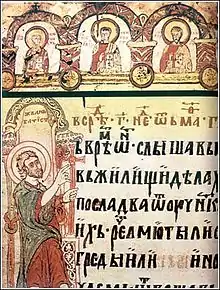Domentijan
Domentijan (Serbian Cyrillic: Доментијан; c. 1210-after 1264), also known as Domentijan the Hilandarian (Доментијан Хиландарац), was a major figure in medieval Serbian literature and philosophy.[1] He was a monk at the Hilandar Monastery and a contemporary of Saint Sava.[2] In fact, he accompanied St. Sava when the latter visited the Holy Land. He was much respected by the royal court, as well as by the monks on Mount Athos. Athonite scribe Teodore's account of his troubles, recorded on the pages of John Exarch's Hexameron (Šestodnev), which Teodore was copying at Domentijan's request, contains many references concerning Domentijan's humanity and assistance extended to him. The manuscript is now in the State Historical Museum in Moscow.
Domentijan | |
|---|---|
| Native name | Доментијан Хиландарац |
| Born | 1210 Grand Principality of Serbia |
| Died | 1264 (aged c. 54) |
| Occupation | monk, scribe, writer, philosopher |
| Language | Serbian Old Church Slavonic |
It may be concluded that Domentijan was essentially a hymnologist who wrote biographies to two Serbian saints but, in fact, glorified monasticism and Christianity.
Life
Hieromonk Domentijan started his monastic life in Sava's monastery Žiča. Undoubtedly an exemplary monk, he was subsequently sent by the court to join Sava in Hilandar. It was there that Sava asked Domentijan to accompany him on his second pilgrimage to Jerusalem.
Biography of St. Sava
Domentijan's biography of St. Sava, written c. 1253 (and an earlier one of St. Simeon Nemanja) was expressly written by order of the royal court of King Stefan Uroš I, seven years after Sava's death. It is a work giving an account of St. Sava's life, yet it is also an apotheosis of monasticism. Domentijan's style is characterized by fluent narration, panegyric diction, an abundance of theological and mystical elements with an emphasis on a spiritual and clearly monastic point of view. Domentijan wrote it in the kellion (cell) built by Sava at Karyes, the Athonite seat.
Biography of St. Simeon
For his biography of St. Simeon, Domentijan used material from works of previous authors and thus unintentionally preserved some of them until contemporary time.[2] He drew freely from Stefan the First-Crowned's biography of Stefan Nemanja; one-third of his own biography of St. Sava; and in the Panegyric to St. Simeon, he used a few lines from Ilarion's Panegyric to St. Vladimir.
Legacy
He is included in The 100 most prominent Serbs. Đura Daničić published Domentijan's texts in Belgrade in 1865.[2] Srpska književna zadruga adapted them to modern language in 1938.[2]
See also
- John the Deacon
- Teodosije
- Danilo II, Serbian Archbishop
- Stefan Dušan
- Elder Siluan
- Teodosije the Hilandarian (1246-1328), one of the most important Serbian writers in the Middle Ages, and the next great Athonite in the Serbian literature of the 13th century.
- Elder Grigorije (fl. 1310-1355), builder of Saint Archangels Monastery
- Antonije Bagaš (fl. 1356-1366), bought and restored the Agiou Pavlou monastery
- Lazar the Hilandarian (fl. 1404), the first known Serbian and Russian watchmaker
- Pachomius the Serb (fl. 1440s-1484), hagiographer of the Russian Church
- Miroslav Gospel
- Gabriel the Hilandarian
- Constantine of Kostenets
- Cyprian, Metropolitan of Kiev and All Rus'
- Gregory Tsamblak
- Isaija the Monk
- Grigorije of Gornjak
- Radoslav's Gospel (Inok of Dalša)
- Rajčin Sudić
- Romylos of Vidin
- Marko Pećki
- Grigorije Vasilije
- Danilo III (patriarch)
- Anonymous Athonite
References
- Mateja Matejić and Dragan Milivojević, "An Anthology of Medieval Serbian Literature in English" (Columbus, Ohio, Slavica Publioshers, Inc., 1978), p. 55
- Đorđe Radojičić (1971). Živan Milisavac (ed.). Jugoslovenski književni leksikon [Yugoslav Literary Lexicon] (in Serbo-Croatian). Novi Sad (SAP Vojvodina, SR Serbia): Matica srpska. p. 98.
Sources
- Ђорђе Трифуновић (1963). Доментијан. Београд: Нолит.
- Milojević, Snežana J. (2015). "Jevanđelje u Domentijanovom Životu Svetoga Save". Zbornik Radova Filozofskog Fakulteta u Prištini. 45 (2): 63–90. doi:10.5937/zrffp45-8564.
